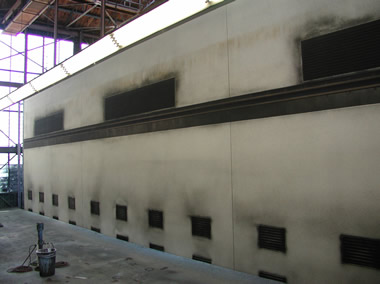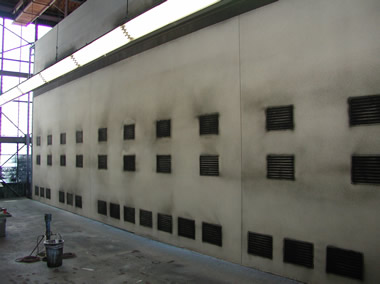Table of Contents
The Green Hornet Case Study
Custom Backings without Custom Photography
Pierre Steele’s Portfolio
Recent Catalog Additions
We’re on Facebook!
Case Study: The Great Debate:
Backings versus Green Screen
| Production:
The Green Hornet |
Production Designer: Owen Paterson
Supervising Art Director: Greg Papalia |
| Art Director(s): Chad S. Frey, Randy Moore, John Berger, Eric Hugunin, Ben Edelberg |
Products: Day and Night Custom Photo Backings — CT-756 & CT-757 - 240' x 28' each;
Painted Backings — 90’ x 36’ and 70’ x 36’ |
Set Names:
Interior offices at The Sentinel (Photo backings)
LA Times print press building (Painted backings) |
More and more design teams are confronted with the dilemma of whether to use backings or green screen in their productions. Here’s why The Green Hornet chose to use backings for its primary sets:
Production value
For the interior offices of The Sentinel set, Pierre Steele photographed the film’s location in Century City to create the day and night photo backings. Using backings, allowed the art department and the Director of Photography to have more control over the final image. On the other hand when a production uses green screen, the Visual Effects Department controls the final product, which is ultimately determined months after principal photography has been completed.
“Anything you can provide fully in-camera enhances the production” says Greg Papalia, The Green Hornet’s Supervising Art Director. “Of the three options—green screen, painted backings and photo backings—green screen should be the last option, not the first. Almost every film, regardless of size, grapples with creating something that may not exist in reality. Backings provide the Director and actors with a sense of space and environment, which often helps them give their best performances.”
Cinematographers and Production Designers need to know what they’re lighting for in order to design the lighting scheme. Light contamination can be a major challenge when using green screen, even when everything is calibrated and evenly lit. Backings, on the other hand, do not suffer from the same light contamination issues.
2D backings in 3D productions
The basic principles of art direction—scale, proportion and perspective—don’t change because a film is displayed in 3D. When The Green Hornet started shooting, no one knew it would finish as a 3D production. The backings were planned as separate elements, giving the Director and Director of Photography flexibility to shoot the film as desired.
“The decision to convert to 3D in post didn’t impact the decision to use backings and they performed exactly as needed—and as expected. However, working in 3D requires keeping an eye out for every opportunity to create visual depth, had we known that the film would ultimately be viewed in 3D, I would have generated discussions between JC and our Cinematographer to make sure we were taking full advantage of the backings created for the Sentinel Office set," said Greg Papalia.

CT-756

CT-757
Role of painted backings
A key scene takes place in the three-story tall LA Times print press building, a portion of which was built on a stage. The production design team had a choice: spend a lot of money to build the room’s walls on stage or save money by scenically painting the walls on muslin and hanging the painted backings on the set.
“The image was dirty walls with huge vents, so JC Backings custom painted one 90’ x 36’ backing and one 70’ x 36’ backing to match to the location’s real walls for about 10% of the cost to build them, this also gave us the advantage of easily and quickly tracking the walls out of the way for camera access” said Papalia.


Budget considerations
When using green screen, productions often have to pay for visual effects to create the view from every window, which can become very expensive. For The Green Hornet, the sheer amount of windows in the Sentinel office set made backings the more cost-effective option.
Pre-production
The Art Department and JC Backings spent a lot of time in pre-production planning the shoot to ensure the best end-result. Between location scouts, reviewing models and designing the logistics of the actual shoot, JC Backings was able to create a backing that delivered everything the production required and in the time frame they needed it
“JC Backings brings a long tradition of scenic art and its underlying principles to every image they create” said Papalia. “They truly understand the principals of perspective, sight lines, camera, scale, and proportion, which is why I choose to work with them again and again.”
The Green Hornet project is another example of why JC Backings is the preferred choice of more production, art and design professionals.
Click here to see the final images CT-756 and CT-757 created for The Green Hornet
|

